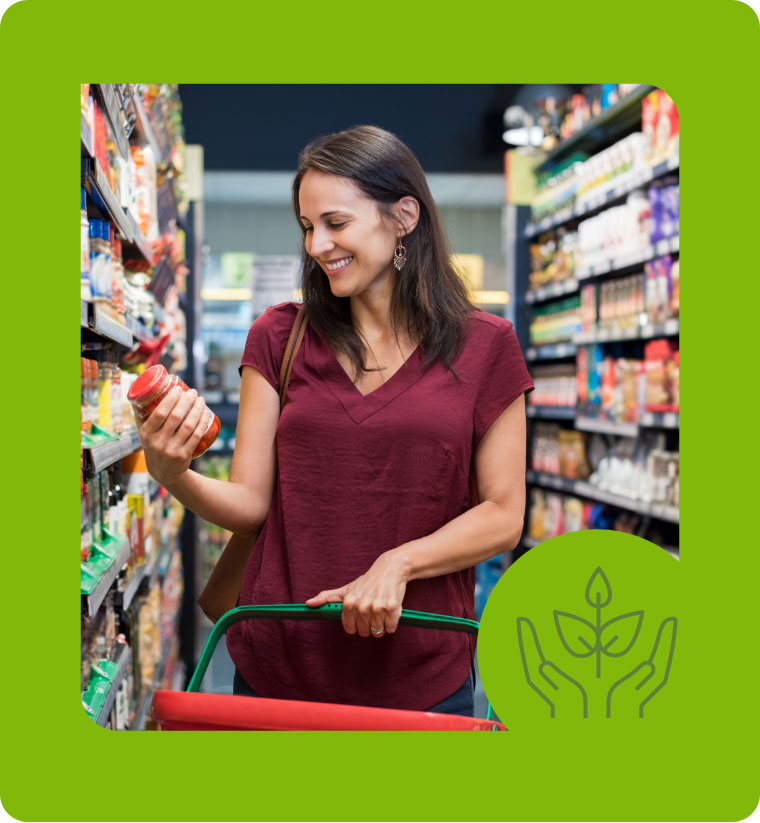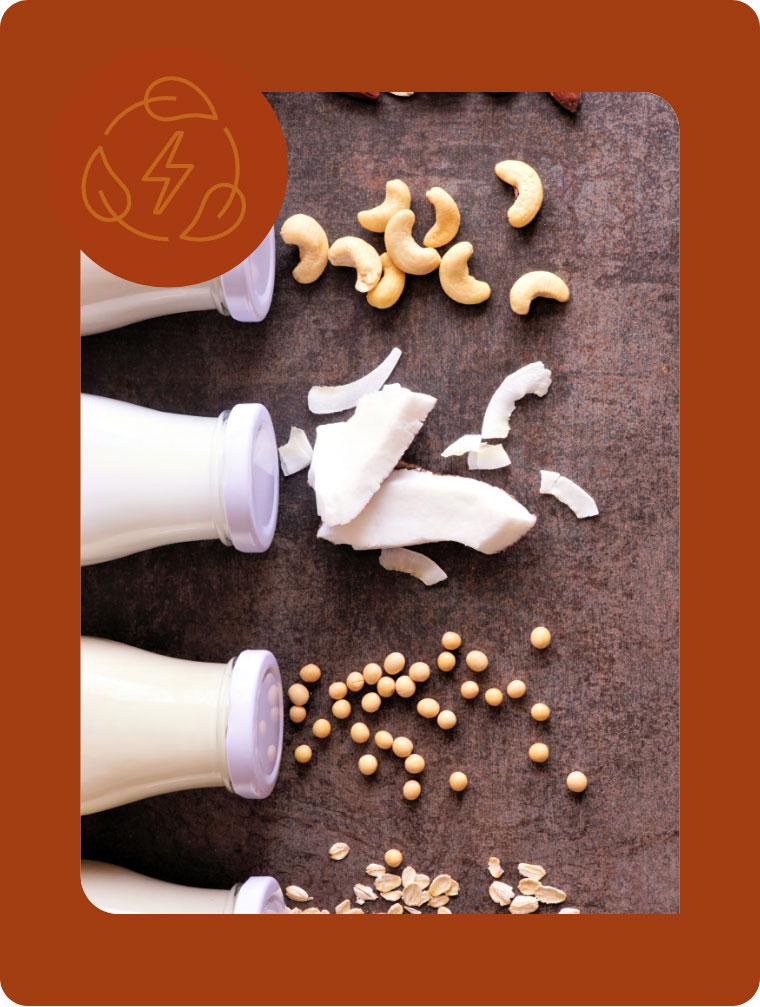We’re here to provide you with more information or help answer any questions you might have. Send us a note and we’ll get back to you as soon as possible.


Wholesome indulgent snacks. Multifunctional and upcycled ingredient and flavor exploration. Plant-based proteins. Holistic health. Biodegradable packaging.
These formulator trends continue to shape the future of food and beverage in 2024. Global economic impacts and new consumer demands for ingredients across the landscape are also shaping the agile world of the current food and beverage industry. Manufacturers and brands must adapt to the food and beverage industry trends driven by these factors for success and longevity.
From shifting priorities to continuously discovering ways to meet their health goals, consumer choices impact the food and beverage industry at every step of production. Ingredients are taking center stage while driving the change in 2024, with consumers prioritizing everyday foods with functional benefits with clean-label claims. Sustainability is no longer a bonus feature, and successful manufacturers understand that consumers value claims like 'upcycled ingredients' and 'longer shelf life.'
For suppliers and formulators, navigating these ever-changing determinants can be daunting, and identifying your customers' needs is poised to be trickier than ever. What are the latest trends in the food and beverage industry that are driving consumer buying behavior? What ingredients can help reformulate recipes to meet their needs? Although the upcoming year has similarities to the last, 2024 will focus on optimizing value with an emphasis on sustainability and ingredients.
Our Foodology by Univar Solutions team forecasts seven (7) trends that will likely shape the food and beverage industry's overall outlook for 2024 and provide a first-mover advantage for new product introductions throughout the marketplace.


1. Ingredients are king
In today's culinary world, specific functional ingredients drive innovation and consumer preference. For example, in the sugar reduction space, shoppers value multifunctional hero ingredients like sweeteners that can fortify foods and beverages with fiber. 45% of global consumers feel they have actively taken more interest in health-boosting ingredients in the past two years. 51% of launches in the rest of Europe contain a sugar reduction claim that also claims to have an added fiber ingredient. Fructooligosaccharides (FOS), citrus fibers, inulin, and soluble fibers are commonly used in these cases.
With convenience and value being constantly sought after by consumers and the viral 'girl dinner 'phenomenon (referring to the TikTok trend of women choosing snack boards for meals instead of traditional entrées), snacking culture is gradually returning. Manufacturers will need to take advantage of creating more nutrient-dense versions of their offerings and bulking up their offerings with ingredients such as fiber. Functional fiber types include:
|
|
Ingredients are also at the forefront of the clean-label revolution. According to FMCG Gurus, today's customers are keen on scrutinizing labels, with 78% of consumers claiming clean-label claims are more appealing. Therefore, keeping labels simple, recognizable, and using minimally processed ingredients is critical in influencing buying behaviors.


2. Food and beverage sustainability
The culinary world is witnessing a paradigm shift towards sustainability that transcends conventional organic farming. Regenerative agriculture practices, regional sourcing, and circular economy principles are gaining traction throughout the global food and beverage industry. The movement is about more than just producing food – it's a holistic approach encompassing waste reduction through upcycled foods and adopting biodegradable or plant-based packaging materials.
According to a study conducted across ten countries and more than 5,000 consumers on food waste and potential solutions, nearly 70% said they would be keen to purchase products highlighting claims that minimized food waste. 72% of consumers also felt that the longer shelf life for products cuts food waste, with one-third considering switching to a brand that offers it.
Foodology by Univar Solutions offers sustainable solutions across various applications:
|
|
Moreover, the industry is taking strides in water conservation and carbon emission reductions, acknowledging its crucial role in sustainable food production. This food industry trend reflects a commitment to responsible practices to reduce environmental impact while fostering a healthier planet


3. Proactive health
Consumers today are increasingly conscious of their well-being, leading to a surge in demand for foods that offer both sustenance and health benefits. This trend embraces a broad spectrum of health-conscious choices, including prebiotics, adaptogens, and botanicals that contribute to overall wellness. Women's health is also becoming a priority for food and supplement innovators. Solutions to mellow the effects of menopause, such as energy bars, sleep teas, and mocktails, help women cope with energy shifts throughout their cycle.
Healthy aging is a key priority. Among 78% of American vitamin supplement users post-pandemic, 34% have increased their usage. 47% of millennials feel that it helps them maintain overall physical well-being, which ties into their long-term strategy for healthy aging. 78% of U.K. consumers agree that getting the right vitamins and minerals is critical and directly linked with good health. Iron and calcium are top in patents related to food and drink fortified with select micronutrients.
The bone health market has expanded, with consumers gradually learning the importance of maintaining and strengthening their bones. Vitamin D is crucial for helping the body absorb calcium and, thus, has a positive perception in the market. However, recent research has proven that without adequate Vitamin K, there is a potential risk of calcium being deposited in soft tissues, potentially leading to health concerns. Vitamin K also activates a protein that helps calcium bind to bone tissue.
In the past, medicinal mushrooms were mainly consumed in Asian countries. Mushrooms like Lion's mane, Reishi, and Tiger milk mushrooms are increasingly seen in products boosting cognitive health, mental well-being, and preventative health. The key to introducing these ingredients into food and beverage products has been optimizing them to work synergistically with ingredients consumers are already looking for and familiar with.


4. Value engineering in the F&B industry
Amid economic uncertainties and rising expenses, we are officially in the 'Renaissance of Value' through food cost engineering. Consumers are re-evaluating their spending, including food and beverage services and dietary choices when grocery shopping. This trend emphasizes the quest for value in products that offer versatile uses, extended shelf life, and stress-free flavor building.
Prompted by a shift in consumer behavior towards more value-conscious purchases, brands will face challenges demonstrating why their offerings are worth the cost. They will have to rely heavily on formulation efficiencies, promoting functional benefits, and the overall customer experience their products can provide. Adding sustainable claims to their proposition will help to solidify choices among the mindful nutritionist shopper. Health is the new post-pandemic premium, with 42% of global consumers increasing their purchase of functional and/or fortified food and beverages.
Food and beverage brands must make nutritional information and satiety messaging transparent to help customers find the right balance between product selection and budget management. Using functional or premium flavor offerings will enhance the product's value in the consumer's eyes throughout 2024 and the following years.


5. Travel through food
Mintel forecasts that as the economy stabilizes, consumer spending habits will remain primarily conservative, but they will opt for fun and experimentation – and that's where the flavor comes in!
Over the past three years, food and beverage launches with new flavors have grown by 23%. A fascinating trend in the culinary world is the exploration of diverse global flavors and lesser-known cuisines. Consumers are eager to embark on culinary journeys that transcend borders, embracing regional ingredients and recipes from various cultures. This trend encourages an open-minded approach to experiencing new and unique taste sensations and expanding culinary horizons beyond familiar territories without leaving home. The need for travel and escapism on a budget has led to more exploration of cuisines such as Korean – which has gained widespread popularity in the United States and is now penetrating the mainstream food market in Europe.
40% of French consumers are keen to try flavors inspired by food from other countries, with 44% stating they would like to see this in sauce launches, particularly from Asian and Indian cuisine. It also allows manufacturers to give consumers better-for-you options by optimizing the health benefits of these ethnic cuisines. Nearly half of consumers worldwide believe that flavors associated with better-for-you foods influence their choices, especially cuisines associated with floral flavors and functional ingredients. Five flavor ingredients to support the trend include:
|
|


6. Optimise plant-based foods
The evolution of plant-based foods is a transformative trend, moving beyond the realm of mock meats to embrace authentic plant-based products. This shift involves using vegetables, pulses, nuts, seeds, and innovative methods like precision fermentation. Moreover, developing sustainable plant-based fish alternatives marks a significant step towards ethical and environmentally friendly food choices.
Although consumers may opt for value, a new population segment is interested in plant-based food and beverage offerings. 53% of processed meat consumers in Spain have cut their consumption for financial reasons. Plant-based meat manufacturers can tap into this market by highlighting the cost, health benefits, and quality of their products. Over the past five years, manufacturers have recognized consumer health goals to meet their protein needs. Meat substitutes comprise the category delivering the highest number of launches with added protein ingredients.
Despite the rise in plant-based meat consumption, the main skepticism continues to be taste and flavor, with 48% of U.S. consumers avoiding meat alternatives, highlighting a key area of focus for formulators to dive into while developing new recipes. In the absence of animal fat, manufacturers must find solutions to mimic sensorial aspects such as juiciness, aroma, and the overall mouthfeel of familiarity with meat while catering to health-conscious consumers. Ingredients that support plant-based food solutions include:
|
|
Clean-label consumer demands present a new challenge for formulators, who must now find other solutions to better support these claims for the process involving how plant-based meat is made. Cleaner methylcellulose alternatives to the texturizers and binding agents for plant-based meat include citrus fiber, lentil flour (including chickpea flour), potato flour, and pregelatinized corn starch.


7. Functional treats and indulgences
While consumers desire healthier lifestyles, the demand for indulgences that provide pleasure and added functional benefits is increasing. In Germany, 81% of dessert eaters feel that their desserts can offer health benefits, while also being indulgent. Specific nutrition credentials such as high and/or added protein claims have seen an increase in launches. High protein offerings offer satiety with longer-lasting energy.
40% of U.S. consumers track their sugar consumption to maintain general health and wellness, followed by 35% of those who want to lose weight. Food and drink manufacturers are under pressure to produce reduced sugar variants of their products without compromising on taste. Developments in alternative sweeteners and taste modulators and improvements in the taste of stevia-based sweeteners are paving the way forward.
Snacks are another category undergoing a massive transformation in health and functional claims despite being viewed as a treat. In Europe, there's been a significant rise in the implementation of traffic light labeling, which came after increased legislative scrutiny over High Fat Sugar and Salt (HFSS) foods, creating widespread consumer awareness. 63% of adults feel that the traffic light system allows them to choose healthier foods and drinks. Nutritional attributes are taking center stage with a rise in launches with essential vitamins and minerals such as magnesium, omega-3, and vitamin E.
The first steps into trends for food and beverages in 2024 and beyond
Health is no longer something manufacturers, producers, or food formulators write off as a fad – brands must now incorporate elements of functionality and fortification to convince consumers of the value they can offer. Consumers are more aware of food ingredients and their implications for our bodies. Instilling trust by providing clean and sustainable solutions will become vital. Ingredients will play a significant role in every aspect of the production process in 2024. The public wants trust in product formulations and brand transparency to help inform how to provide the best nutrition for every family member, including pets.
With the advent of A.I. and A.R., convenience is an evolving concept that will accelerate the need to engage people and change how they shop for food and enjoy dining experiences, particularly for Gen Z consumers who crave 'unique' and 'exciting' culinary adventures. Brands will be challenged, and their willingness to adapt and stay flexible will be strategic to excel in 2024 and thereafter.
Create your next winning recipe with Foodology by Univar Solutions.
References
Mintel Report: 2024 Global Consumer Trends https://www.mintel.com/
Food Matters Live, 10 key trends and market dynamics in functional nutrition for 2023 https://foodmatterslive.com/article/10-key-trends-and-market-dynamics-in-functional-nutrition-for-2023/
Food Ingredients 1st, Functional food meets flavor: Cognitive health top of mind, sleep, and relaxation in focus https://www.foodingredientsfirst.com/news/functional-food-meets-flavor-cognitive-health-top-of-mind-sleep-and-relaxation-in-focus.html
Food Navigator Europe, Explore 10 pathways to greater efficiency in alternative protein. https://www.foodnavigator.com/
Innova Market Insights, Top 10 Trends Opportunities for 2024 https://www.innovamarketinsights.com/






